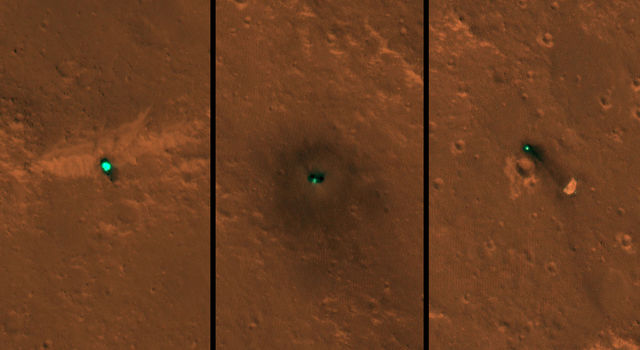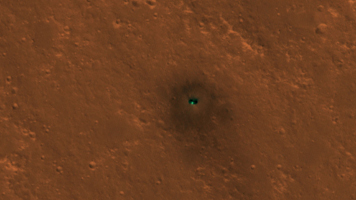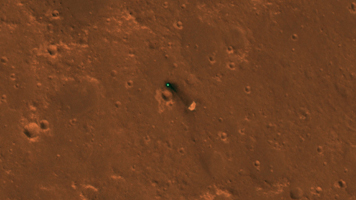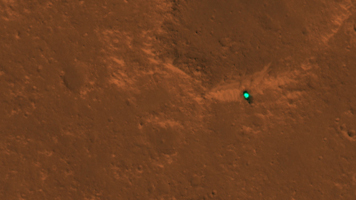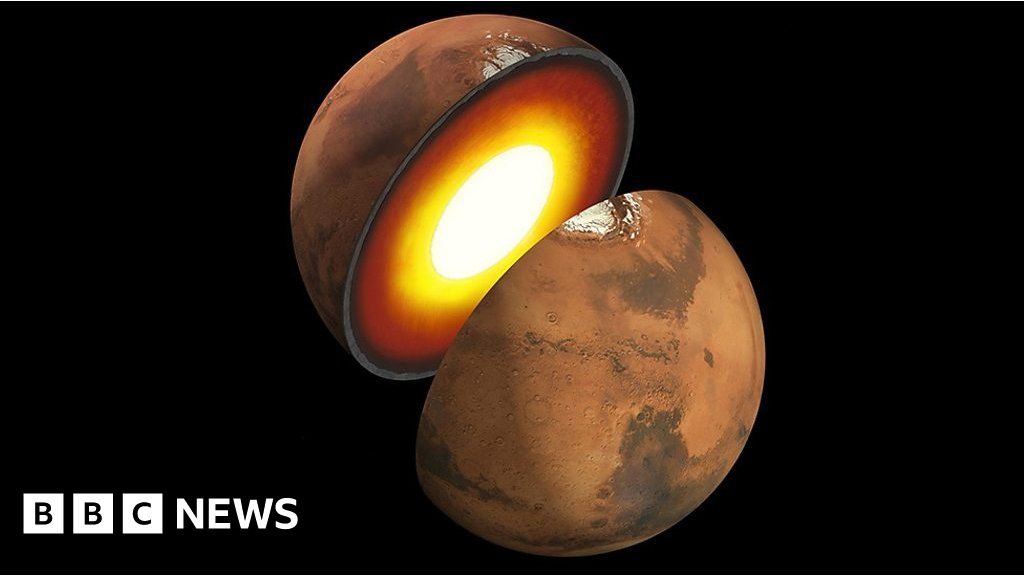And the first ever "sounds" of Martian winds!

One of InSight's 7-foot (2.2 meter) wide solar panels was imaged by the lander's Instrument Deployment Camera, which is fixed to the elbow of its robotic arm.
Credits: NASA/JPL-Caltech


The spectrogram of vibrations (frequency spectrum over time) recorded by two of the three sensors of the short period seismometer on NASA’s InSight lander on Mars. This spectrogram shows the first 1,000 seconds, roughly 20 minutes, of InSight’s first seismic data from the Red Planet. The vibrations of the lander are due to the wind passing over the spacecraft, particularly the large solar arrays. The annotation indicates the 20-second raw sound clip played earlier.
Credits: NASA/JPL-Caltech/CNES/UKSA/Imperial College London/Oxford

An annotated image of the surface of Mars, taken by the HiRISE camera on NASA’s Mars Reconnaissance Orbiter (MRO) on May 30, 2014. The contrast has been enhanced in this image to better show the region where InSight landed on Nov. 26, 2018. The labels show the approximate position of NASA’s InSight lander in Elysium Planitia. Overlaid on top are the direction of the vibrations detected by InSight’s science instruments. The diagonal lines, faintly seen moving from upper left corner to the lower right corner of the image, show the paths of dust devils on the Martian surface. The vibrations recorded by InSight line up with the direction of the dust devil motion.
Credits: NASA/JPL-Caltech/University of Arizona/Imperial College London

A copy of one of the sensors on NASA InSight’s seismometer, compared to a 2-euro coin (about 1 inch wide). The short-period seismometer has three of these sensors.
Credits: Imperial College London

This illustration is a still frame from NASA's Experience InSight app (https://eyes.nasa.gov/insight). It shows in blue outline the location of the pressure sensor inlet, tucked inside the Wind and Thermal Shield. The pressure sensor inlet is part of InSight's Auxiliary Payload Sensor Subsystem.
Credits: NASA/JPL-Caltech

This illustration is a frame from NASA's Experience InSight app (https://eyes.nasa.gov/insight) that shows the location of the spacecraft's pressure sensor inlet, after the Wind and Thermal Shield (WTS) has been deployed. (The real InSight spacecraft has not yet deployed its instruments or the WTS.) The pressure sensor inlet is outlined in blue and the WTS (white dome) has been placed over InSight's seismometer on the ground on Mars. The sensor is part of InSight's Auxiliary Payload Sensor Subsystem.
Credits: NASA/JPL-Caltech

One of InSight's 7-foot (2.2 meter) wide solar panels was imaged by the lander's Instrument Deployment Camera, which is fixed to the elbow of its robotic arm.
Credits: NASA/JPL-Caltech


The spectrogram of vibrations (frequency spectrum over time) recorded by two of the three sensors of the short period seismometer on NASA’s InSight lander on Mars. This spectrogram shows the first 1,000 seconds, roughly 20 minutes, of InSight’s first seismic data from the Red Planet. The vibrations of the lander are due to the wind passing over the spacecraft, particularly the large solar arrays. The annotation indicates the 20-second raw sound clip played earlier.
Credits: NASA/JPL-Caltech/CNES/UKSA/Imperial College London/Oxford

An annotated image of the surface of Mars, taken by the HiRISE camera on NASA’s Mars Reconnaissance Orbiter (MRO) on May 30, 2014. The contrast has been enhanced in this image to better show the region where InSight landed on Nov. 26, 2018. The labels show the approximate position of NASA’s InSight lander in Elysium Planitia. Overlaid on top are the direction of the vibrations detected by InSight’s science instruments. The diagonal lines, faintly seen moving from upper left corner to the lower right corner of the image, show the paths of dust devils on the Martian surface. The vibrations recorded by InSight line up with the direction of the dust devil motion.
Credits: NASA/JPL-Caltech/University of Arizona/Imperial College London

A copy of one of the sensors on NASA InSight’s seismometer, compared to a 2-euro coin (about 1 inch wide). The short-period seismometer has three of these sensors.
Credits: Imperial College London

This illustration is a still frame from NASA's Experience InSight app (https://eyes.nasa.gov/insight). It shows in blue outline the location of the pressure sensor inlet, tucked inside the Wind and Thermal Shield. The pressure sensor inlet is part of InSight's Auxiliary Payload Sensor Subsystem.
Credits: NASA/JPL-Caltech

This illustration is a frame from NASA's Experience InSight app (https://eyes.nasa.gov/insight) that shows the location of the spacecraft's pressure sensor inlet, after the Wind and Thermal Shield (WTS) has been deployed. (The real InSight spacecraft has not yet deployed its instruments or the WTS.) The pressure sensor inlet is outlined in blue and the WTS (white dome) has been placed over InSight's seismometer on the ground on Mars. The sensor is part of InSight's Auxiliary Payload Sensor Subsystem.
Credits: NASA/JPL-Caltech



